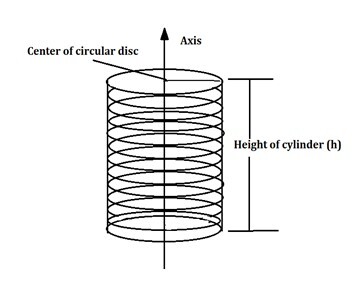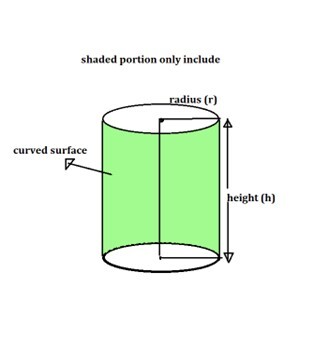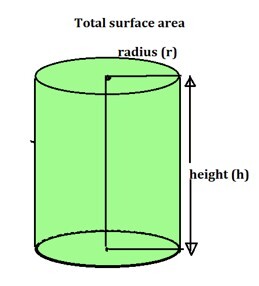
 Data Structure
Data Structure Networking
Networking RDBMS
RDBMS Operating System
Operating System Java
Java MS Excel
MS Excel iOS
iOS HTML
HTML CSS
CSS Android
Android Python
Python C Programming
C Programming C++
C++ C#
C# MongoDB
MongoDB MySQL
MySQL Javascript
Javascript PHP
PHP
- Selected Reading
- UPSC IAS Exams Notes
- Developer's Best Practices
- Questions and Answers
- Effective Resume Writing
- HR Interview Questions
- Computer Glossary
- Who is Who
Cylinder
Introduction
The cylinder obtained by rotating a line segment about a fixed line that it is parallel to is a cylinder of revolution. In our everyday lives, we are familiar with several cylindrical objects. Traditional definitions of a cylinder or cylindrical structure include a three-dimensional solid with a prism-like form and a circle at the base, as pencil, road roller, and pipes are some basic examples of cylinders.
One of the most fundamental curvilinear geometric forms is this one. This conventional viewpoint is still helpful in resolving simple geometric issues. A cylindrical surface, however, is viewed from a complex mathematical perspective as an infinitely curved surface. Today, many current fields of geometry and topology follow this notion. We shall discuss the features, varieties, and formulas associated with cylindrical constructions in this article.
Today we will discuss the properties of the cylindrical body, the parameters used in the shape, and deal with some problems.
Cylinders
It is made of parallel circular discs; we can say that a large number of circular discs will make a cylinder. If we join all the centres of the circular disc, A line segment joining the axis will be the height of the cylinder.

The cylinder seems to be a circle from the top.
The front view of the cylinder looks like a rectangle. It has curved lines, not straight as cube and cuboid
Types of cylinders
Elliptical cylinder An elliptical cylindrical structure is a cylinder with elliptical bases.
Right circular cylinder By rotating the rectangle around one of its sides as an axis, an object known as a right circular cylinder is created. The cylinder is referred to as a right circular cylinder if the axis (one of the rectangle's sides) is perpendicular to the radius (r). The height (h) of a cylinder is the distance between its round faces at its top and bottom, which are parallel to one another.
Oblique cylinder An oblique cylinder is one in which the circular faces are sideways rather than over one another, and the axis creates an angle other than a straight angle to the bases.
Hollow cylinder A hollow cylinder is a cylindrical construction that has a difference between its outer and inner surface diameters and is empty from the inside. Since the inner and outer diameters are variable, they can have various inner and outer lateral surface areas.
Formulas of cylinders
In three-dimensional geometry, the entire area filled by a cylinder is known as its area. The total surface area of two circular bases plus the lateral surface area makes up the area of a cylinder. Between two circular bases, there is a curved or lateral surface. When the curved surface is opened, a rectangular figure is represented. Height, radius, axis, side, and base are the many variables used to calculate the cylinder area. The cylinder's radius is equivalent to the distance between its two circular sides. The perpendicular distance between two circular sides is referred to as the cylinder's height, and its radius can be written as (r). The cylinder's height is specified as (h)
A cylindrical structure's surface area may be divided into two categories.
Curved surface area (CSA)
Total surface area (TSA)
Curved surface area or lateral surface area
Lateral surface area is another name for curved surface area. The area of a curved surface is the area of a cylindrical structure except for the area of its circular base.
In general, square units like centimeter square, meter square, etc. are used to measure area.
A rectangular form may be seen if the cylinder's curved surface area is opened.
Two circular edges on the curved surface area may match the circle's diameter in size.
The circle's circumference may be calculated using the formula 2r.
Therefore, the rectangle's length (after opening the curved surface) is 2r, and its width is (h). As a result, the area of the curved surface is 2?rh.
So, the formula is given by
$$\mathrm{The\: curved\: surface\: area\: of\: the\: cylinder\: = 2?rh\: square\: units.}$$

Total surface area
The total surface area of the cylinder is the sum of the area of the two circles and the curved or lateral surface area and it is given by
Total surface area = area of two circles + curved surface area
$$\mathrm{=2Ã?r^2+2?rh }$$
$$\mathrm{ =2?r(r+h)\: square\: unit}$$

Volume
Every solid or three-dimensional shape has a volume that takes up some space. The area that the cylinder occupies in any three-dimensional plane is its volume. The capacity of a cylinder indicates how much water might be contained within.
$$\mathrm{Volume\: of\: cylinder\: = ?r^2 h\: cube\: units}$$
Solved examples
1)What is the radius of the cylinder if the height of the cylinder is 12cm, and the volume of the cylinder is to be 8478cm3?
Answer:
Given that, the height of the cylinder (h) =12cm
Volume of the cylinder (v)=8478cm3
as we know,
volume of cylinder(v) = ?r2 h
$$\mathrm{8478 = 3.14Ãr^2Ã12}$$
$$\mathrm{8478 = 37.68Ãr^2}$$
$$\mathrm{225 = r^2}$$
Hence, r = 15cm
So the radius of the cylinder is 15cm.
2)What is the volume of the cylindrical shape of a water tank if the diameter and height of the tank are 30cm and 40cm, respectively?
Answer:
Given, height of the cylindrical water tank (h) = 40cm
Diameter of the cylindrical tank (d) = 30cm
so, the radius of the cylindrical tank (r)= 30/2 =15cm
as we know,
the volume of the cylinder = ?r2 h
$$\mathrm{= 3.14Ã15Ã15Ã40}$$
$$\mathrm{= 28260cm^3}$$
3) What is the total surface area of a cylinder whose radius and height are 7cm and 20cm, respectively?
Answer:
Given,
Radius of the cylinder(r) = 7cm
Height of the cylinder(h) = 20cm
as we know,
The total surface area of the cylinder = 2?r(r+h)
$$\mathrm{= 2Ã3.14Ã7Ã(20 +7)}$$
$$\mathrm{ = 1,186.92cm^2}$$
So, the surface area of the cylinder is 1,186.92cm2.
Conclusion
A cylindrical construction has zero vertices, two edges, one curved surface, and two bases. It has two bases, like a prism. Their forms may be divided into four categories: hollow cylindrical structures, elliptical cylinders, right circular cylinders, and cylindrical structures. A cylindrical construction has two parallel bases, and the distance between the two bases is referred to as its altitude or height.
The Curved surface area of the cylinder = 2?rh square units.
-
The total surface area of the cylinder = area of two circles + curved surface area
$$\mathrm{= 2Ã?r^2+2?rh}$$
$$\mathrm{= 2?r(r+h) \: square\: unit}$$
The volume of the cylinder = ?r2 h cube units
FAQs
1. A Cylinder Has How Many Faces?
In a cylinder, there are two flat circular sides and one curved surface. Thus, it has three faces altogether.
2. Does the cylinder have vertices?
Two parallel, round sides that make up a cylinder have the same form. However, because of its curvature, it lacks any vertices.
3. What other cylinder kinds are there?
Right circular cylinders, oblique cylinders, elliptical cylinders, and hollow cylinders are the four different forms of cylinders.
4. What makes a cylinder a 3D shape?
A cylinder is a three-dimensional form that has two parallel, round sides on either end. One side that curves. No vertices or edges.

